Question
Question: The blocks shown in the figure have equal masses. The surface of A is smooth but that of B has a fri...
The blocks shown in the figure have equal masses. The surface of A is smooth but that of B has a friction coefficient of 0.10 with the floor. Block A is moving at a speed of 10ms−1 towards B which is kept at rest. Find the distance travelled by B if (Takeg=10ms−2)
a) the collision is perfectly elastic and
b) the collision is perfectly inelastic.

Solution
In the question, velocity of the first object and the friction coefficient of A and B is given. By substituting the values in the equation of the distance and relating the equation of mass and velocity, we get the value of the distance of the second object.
Formula used
The expression for finding the distance is,
W=mg×d
Where,
m be the mass, g be the acceleration due to the gravity and d be the distance.
Complete step by step solution
Given that
Velocity of the first object v1=10ms−1
Velocity of the second object v2=0
v1 and v2 be the velocity of A and B respectively after the collision
a) the collision is perfectly elastic
m1+mv2=v1+v2
Substitute the known values in the above equation, we get
⇒10+0−v1+v2
Simplify the above equation we get,
⇒v1+v2−10.............(1)
Now, v1−v2=−(v1−v2)
Substitute the known values in the above equation, we get
⇒v1−v2=−(10−0)
⇒v1−v2=−10............(2)
Subtracting the equation 2from the equation 1, we get
⇒2v2−20
Simplify the above equation we get,
⇒v2=10ms−1
Now we take the deceleration of B, we get
B=μg
According to the work energy principle
⇒0.5×m×02−(0.5)×m×v2
⇒W=−μ×mg×d
Here d is the distance travelled by B
⇒d=2×0.1×10100
⇒d=50m
b) the collision is perfectly inelastic.
⇒m1×u1+m×u2=(m+m)×v
Substitute the known values in the above equation, we get
⇒m1×10+m×0=(m+m)×v
⇒m1×10+m×0=(2m)×v
⇒v=210
⇒v=5ms−1
Now, the two blocks are moved together and sticking to each other, we get
Now apply the principle of work energy, we get
⇒(0.5)×2m×02−(0.5)×2m×v2
⇒d2=52(0.1×10×2)
⇒d2=12.5m
Therefore, the distance travelled by the B is 12.5m.
Note: In the question, we find the value of before collision and after collision and then we equate the values because the collision is perfectly elastic so we get the value of the distance of the second object. But in the perfectly inelastic we equate the value of the two masses then we find the value of the distance of the second object.
